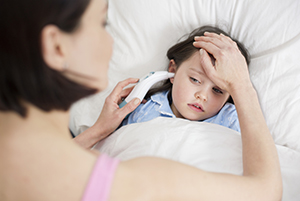When Your Child Has Kawasaki Disease
When Your Child Has Kawasaki Disease
Kawasaki disease is a rare illness that most commonly affects children from birth to age 5, but can sometimes affect children up to the age of 13. It is a type of vasculitis. Vasculitis means inflammation of the blood vessels. It can affect the whole body, including the blood vessels of the heart (coronary arteries). The cause of Kawasaki disease is unknown. Without treatment, affected children are at higher risk of developing problems with the coronary arteries. Other areas of the heart may also be affected. With timely treatment, most children recover with no lasting problems.
What are the signs of Kawasaki disease?
The most common sign of Kawasaki disease is a fever. The fever is usually high between 102°F to 104°F (38.8°C to 40°C). It tends to rise and fall, but stays above 101.3°F (38.5°C). It may not get better even after taking a fever-reducing medicine. The fever usually lasts more than 5 days. To prevent complications, your child's doctor may make an initial diagnosis and start treatment before that time. Other signs include:
Red rash
Red palms
A swollen lymph node, usually in the neck
Swollen hands and feet
Red eyes
Red and dry cracked lips
Red tongue with white spots (called “strawberry tongue”)
Irritability
Fast heart rate
Diarrhea or vomiting
Skin peeling
How is Kawasaki disease diagnosed?
Your child's healthcare provider can usually diagnosis Kawasaki disease based on his or her symptoms and a physical exam. Your child will likely be referred to a pediatric cardiologist. This is a doctor with special training to diagnose and treat heart problems in children. Tests may be done as well. These can include:
Lab tests. Blood and urine samples are taken to check for signs of inflammation. These are also used to help rule out other health problems.
Electrocardiography (ECG or EKG). This test records the electrical activity of the heart through small, sticky patches on the child's chest. The patches are connected to a machine with wires. The machine records the electrical activity. This helps check for problems with heart rhythm and heart structure.
Echocardiography (echo). This test uses sound waves to create a picture of the heart. This can show problems with heart structure, valves, and heart function. This can also show problems with the coronary arteries.
How is Kawasaki disease treated?
Treatment starts as soon as the problem is suspected. A hospital stay of a few days or longer may be needed.
The main treatment for Kawasaki is medicine. These can include:
High-dose gamma globulin. This is given through an IV line. It helps boost the body’s immune system response. It also helps reduce the risk of damage to the coronary arteries and the heart.
High-dose aspirin. This helps reduce inflammation. It also helps reduce the risk of blood clots.
Corticosteroids. These may be given if your child doesn't respond to immunoglobulin.
Your child is observed until symptoms improve. Once at home, your child may need to take low-dose aspirin for 6 to 8 weeks. Your child may need to take aspirin longer if the doctor is concerned about abnormal heart vessels.
After leaving the hospital
Call the doctor right away if your child has any of the following:
Symptoms that return or worsen
Shortness of breath
Chest pain
Your child acts very ill, is unusually sleepy, or is very irritable
Unless advised otherwise by your child’s healthcare provider, call the provider right away if:
Your child is 3 months old or younger and has a fever of 100.4°F (38°C) or higher. Get medical care right away. Fever in a young baby can be a sign of a dangerous infection.
Your child is of any age and has repeated fevers above 104°F (40°C).
Your child is younger than 2 years of age and a fever of 100.4°F (38°C) continues for more than 1 day.
Your child is 2 years old or older and a fever of 100.4°F (38°C) continues for more than 3 days.
Your baby is fussy or cries and cannot be soothed.
Your child has a seizure caused by a fever.
What are the long-term concerns?
After treatment, your child’s health should improve. Some symptoms may not resolve for 2 to 3 weeks. These can include joint pain and peeling skin on the hands and feet.
Going forward, your child may need regular visits with the doctor. Also, routine tests may need to be done to check your child’s heart and blood vessels.
If your child develops heart problems, he or she will need ongoing care. The doctor will discuss your child’s health with you and tell you more about treatment options.
Updated:
February 10, 2018
Sources:
Kawasaki Disease: A Clinician’s Update. Jamieson, N. International Journal of Pediatrics. 2013, ed. 645391, pp. 1-7., Kawasaki Disease: Clinical Features and Diagnosis, UpToDate, Newburger, JW., Diagnosis, Treatment, and Long-Term Management of Kawasaki Disease, Circulation (2004); 100;2747-2771
Reviewed By:
Bass, Pat F., III, MD, MPH,Gandelman, Glenn, MD, MPH,Images Reviewed by Staywell medical art team.
